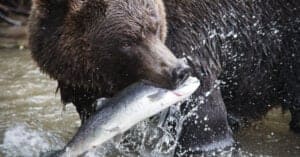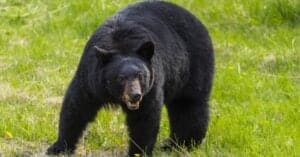Polar Bear vs Kodiak Bear: 5 Key Differences
@media (min-width: 481px) {
.mobile-top-content {
display: none;
}
}
#mobileTopContentCTACarouselControls { overflow: hidden; text-overflow: ellipsis; white-space: nowrap; }
.mobile-top-content .more { color: #fff; }
.mobile-top-content a { color: #fff; text-decoration: underline; }
.mobile-top-content a:hover { color: #fff; text-decoration: underline; }
@media (max-width: 480px) {
.mobile-top-content {
background-color: #06a10b;
color: #fff;
text-align: center;
/*height: 60px;
padding-top:5px;*/
font-size:80%;
/* display: block; */
margin: 0px -30px;
}
}
A polar bear vs Kodiak bear is important to distinguish, given that they are both two of the largest bears in the world. While Kodiak bears are relatively similar to grizzly bears, you may be wondering what traits they share with polar bears. There are more differences between these two beasts than you might think!
In this article, we will address all of the differences between polar bears and Kodiak bears, including their preferred habitats and diets. We will also discuss their size and weight differences, as well as their physical appearances so that you can tell them apart. Let’s get started and learn all about these two bears now!
Comparing Polar Bear vs Kodiak Bear
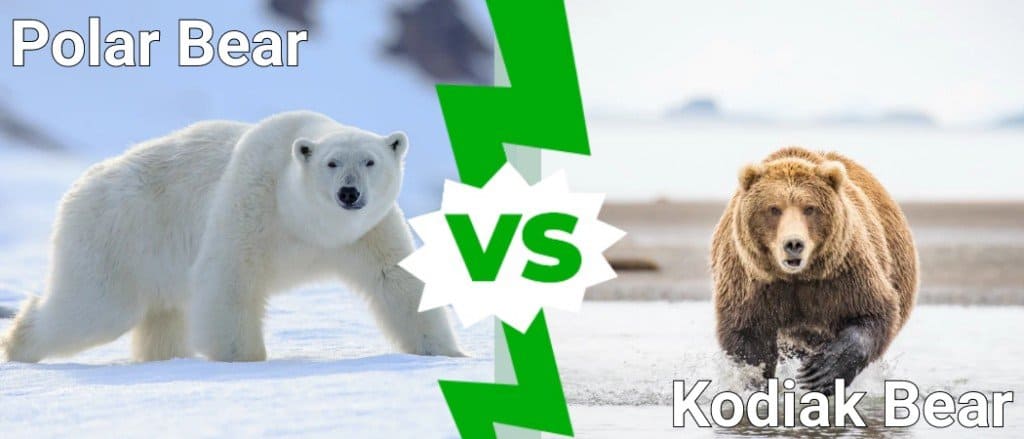
A-Z-Animals.com
| Polar Bear | Kodiak Bear | |
| Size | 6-8 feet tall; 300-1300 pounds | 8-10 feet tall; over 1500 pounds |
| Appearance | White, thick fur with large front paws for swimming; elongated neck | Large boned and bigger in size than polar bears; brown shaggy coats |
| Location and Habitat | Polar seas and locations such as Alaska and Canada | Kodiak Island only; spruce forests and mountains unique to the Kodiak region |
| Behavior | Solitary creature adapted to swimming great distances; stalks its prey or dives deeply | Complex social systems built out of a lack of predation as well as resources; shy but likely less aggressive than polar bears |
| Diet | Seals, seabirds, walruses | Fish, primarily salmon |
Key Differences Between Polar Bear vs Kodiak Bear
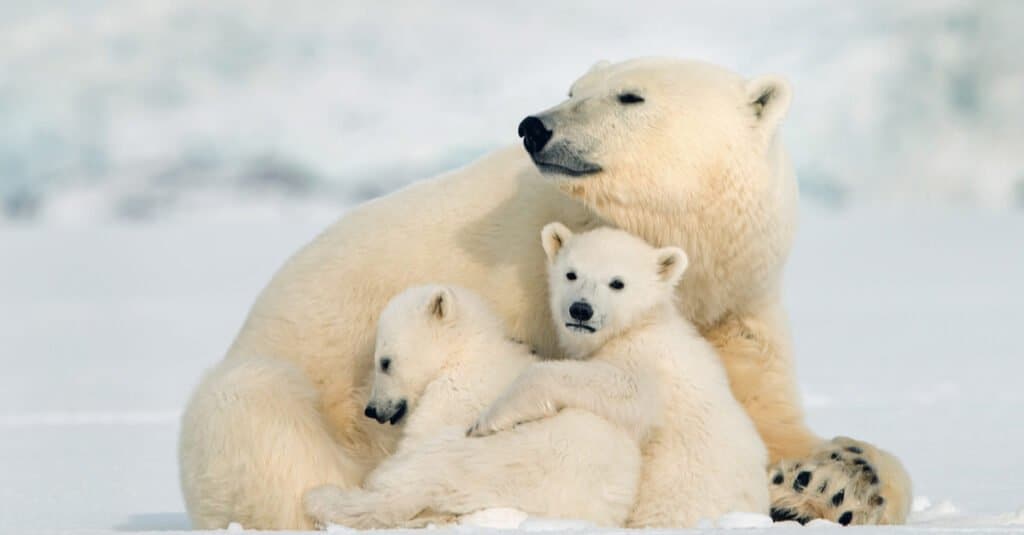
isabel kendzior/Shutterstock.com
There are many key differences between a polar bear vs Kodiak bear. Kodiak bears are much larger than polar bears on average, though some extremely large polar bears have proven this fact incorrect. Polar bears have white fur and long necks, while Kodiak bears have brown and shaggy fur. Finally, polar bears are found in more locations than Kodiak bears, given that Kodiak bears are only found on the Kodiak Islands.
Let’s discuss these differences in more detail now.
Polar Bear vs Kodiak Bear: Size and Weight
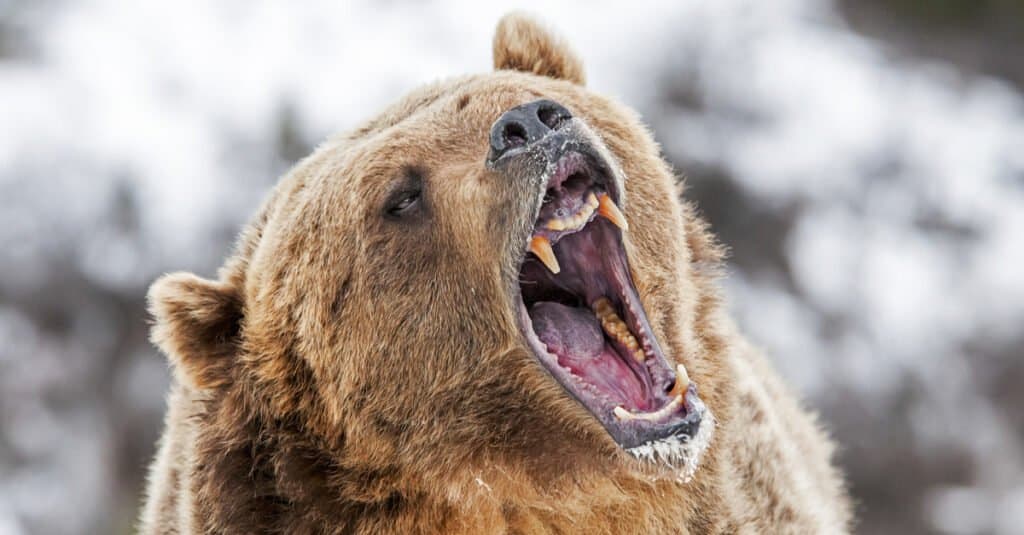
While you may not notice it unless you are looking at a polar bear and Kodiak bear side by side, there are some key differences in their sizes and weights. For example, the average polar bear reaches 6-8 feet tall, while Kodiak bears grow 8-10 feet tall on average. This means that Kodiak bears are taller than polar bears, though there have been some polar bears that reach these sizes, if not greater.
Kodiak bears also weigh more than polar bears, given their larger frames and heights. The average Kodiak bear is over 1500 pounds, while polar bears grow anywhere from 300 to 1300 pounds. However, there are always outliers to this rule, and some polar bears reach this weight limit if not far exceed it.
Polar Bear vs Kodiak Bear: Location and Habitat Preferences
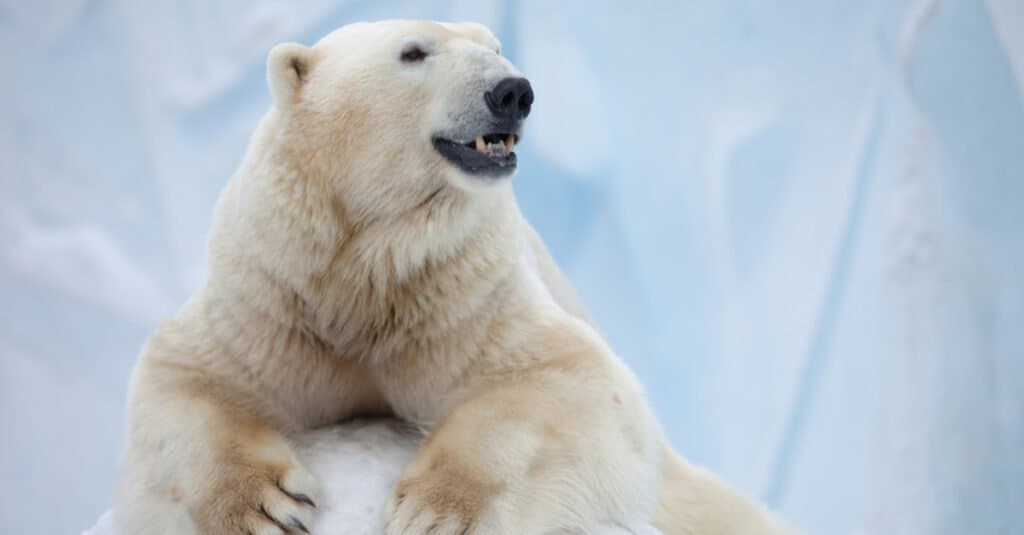
Zhiltsov Alexandr/Shutterstock.com
A primary difference between a polar bear vs Kodiak bear is where you can find them in the wild. Kodiak bears are unique in that they only live on Kodiak Islands, while polar bears are found in many other locations. Let’s talk more about this unique difference in detail now.
The Kodiak Archipelago is located off the coast of Alaska, which places Kodiak bears near polar bears, geographically speaking. However, no other species of bear lives on the Kodiak Islands except for Kodiak bears. Polar bears are found throughout Alaska and the Polar Seas, as well as in Canada, while Kodiak bears only live on Kodiak Island.
Given their drastic location differences, these bears prefer different habitats from one another as well. For example, polar bears spend the majority of their time in snow and frozen tundras, while Kodiak bears enjoy forested areas with rivers and rocky climates.
Polar Bear vs Kodiak Bear: Appearance

iStock.com/Jess Bray
Besides their obvious size differences, polar bears and Kodiak bears have different physical appearances in other ways. Polar bears are well known for their snowy white coats, while Kodiak bears have shaggy brown fur. The Kodiak bear appears to have larger bones than the average polar bear, and polar bears have longer necks than Kodiak bears due to their swimming capabilities.
Polar Bear vs Kodiak Bear: Behavior
The behaviors of the polar bear and Kodiak bear differ greatly. Kodiak bears are very unique in that they have adapted to life on an island with other bears, while polar bears lead solitary life paths. The reason that Kodiak bears have such complicated social structures is due to the fact that they have limited resources as well as limited threats to their environment. Polar bears face more daily threats compared to Kodiak bears, making them more cautious and potentially aggressive overall.
Polar Bear vs Kodiak Bear: Diet

iStock.com/avstraliavasin
A final difference between polar bears and Kodiak bears is their diet. Given that Kodiak bears live and eat on a very particular set of islands, they eat salmon as their primary food source, while polar bears eat a variety of other foods. Polar bears eat seals, seabirds, walruses, and fish, as well as whatever other animals they are able to catch in their environment.
Despite having limited resources when living on an island, Kodiak bears have regular access to salmon and food, while polar bears don’t. This is why Kodiak bears are able to grow so large, as they eat an incredibly potent diet for their species. Polar bears often struggle to find food, though they have complicated hunting techniques that usually bring them success.
More from A-Z Animals
.more-snake-card-image { max-height:140px !important; }
@media (min-width: 481px) {
.mobile-top-content {
display: none;
}
}
#mobileTopContentCTACarouselControls { overflow: hidden; text-overflow: ellipsis; white-space: nowrap; }
.mobile-top-content .more { color: #fff; }
.mobile-top-content a { color: #fff; text-decoration: underline; }
.mobile-top-content a:hover { color: #fff; text-decoration: underline; }
@media (max-width: 480px) {
.mobile-top-content {
background-color: #06a10b;
color: #fff;
text-align: center;
/*height: 60px;
padding-top:5px;*/
font-size:80%;
/* display: block; */
margin: 0px -30px;
}
}
A polar bear vs Kodiak bear is important to distinguish, given that they are both two of the largest bears in the world. While Kodiak bears are relatively similar to grizzly bears, you may be wondering what traits they share with polar bears. There are more differences between these two beasts than you might think!
In this article, we will address all of the differences between polar bears and Kodiak bears, including their preferred habitats and diets. We will also discuss their size and weight differences, as well as their physical appearances so that you can tell them apart. Let’s get started and learn all about these two bears now!
Comparing Polar Bear vs Kodiak Bear

A-Z-Animals.com
| Polar Bear | Kodiak Bear | |
| Size | 6-8 feet tall; 300-1300 pounds | 8-10 feet tall; over 1500 pounds |
| Appearance | White, thick fur with large front paws for swimming; elongated neck | Large boned and bigger in size than polar bears; brown shaggy coats |
| Location and Habitat | Polar seas and locations such as Alaska and Canada | Kodiak Island only; spruce forests and mountains unique to the Kodiak region |
| Behavior | Solitary creature adapted to swimming great distances; stalks its prey or dives deeply | Complex social systems built out of a lack of predation as well as resources; shy but likely less aggressive than polar bears |
| Diet | Seals, seabirds, walruses | Fish, primarily salmon |
Key Differences Between Polar Bear vs Kodiak Bear

isabel kendzior/Shutterstock.com
There are many key differences between a polar bear vs Kodiak bear. Kodiak bears are much larger than polar bears on average, though some extremely large polar bears have proven this fact incorrect. Polar bears have white fur and long necks, while Kodiak bears have brown and shaggy fur. Finally, polar bears are found in more locations than Kodiak bears, given that Kodiak bears are only found on the Kodiak Islands.
Let’s discuss these differences in more detail now.
Polar Bear vs Kodiak Bear: Size and Weight

While you may not notice it unless you are looking at a polar bear and Kodiak bear side by side, there are some key differences in their sizes and weights. For example, the average polar bear reaches 6-8 feet tall, while Kodiak bears grow 8-10 feet tall on average. This means that Kodiak bears are taller than polar bears, though there have been some polar bears that reach these sizes, if not greater.
Kodiak bears also weigh more than polar bears, given their larger frames and heights. The average Kodiak bear is over 1500 pounds, while polar bears grow anywhere from 300 to 1300 pounds. However, there are always outliers to this rule, and some polar bears reach this weight limit if not far exceed it.
Polar Bear vs Kodiak Bear: Location and Habitat Preferences

Zhiltsov Alexandr/Shutterstock.com
A primary difference between a polar bear vs Kodiak bear is where you can find them in the wild. Kodiak bears are unique in that they only live on Kodiak Islands, while polar bears are found in many other locations. Let’s talk more about this unique difference in detail now.
The Kodiak Archipelago is located off the coast of Alaska, which places Kodiak bears near polar bears, geographically speaking. However, no other species of bear lives on the Kodiak Islands except for Kodiak bears. Polar bears are found throughout Alaska and the Polar Seas, as well as in Canada, while Kodiak bears only live on Kodiak Island.
Given their drastic location differences, these bears prefer different habitats from one another as well. For example, polar bears spend the majority of their time in snow and frozen tundras, while Kodiak bears enjoy forested areas with rivers and rocky climates.
Polar Bear vs Kodiak Bear: Appearance

iStock.com/Jess Bray
Besides their obvious size differences, polar bears and Kodiak bears have different physical appearances in other ways. Polar bears are well known for their snowy white coats, while Kodiak bears have shaggy brown fur. The Kodiak bear appears to have larger bones than the average polar bear, and polar bears have longer necks than Kodiak bears due to their swimming capabilities.
Polar Bear vs Kodiak Bear: Behavior
The behaviors of the polar bear and Kodiak bear differ greatly. Kodiak bears are very unique in that they have adapted to life on an island with other bears, while polar bears lead solitary life paths. The reason that Kodiak bears have such complicated social structures is due to the fact that they have limited resources as well as limited threats to their environment. Polar bears face more daily threats compared to Kodiak bears, making them more cautious and potentially aggressive overall.
Polar Bear vs Kodiak Bear: Diet

iStock.com/avstraliavasin
A final difference between polar bears and Kodiak bears is their diet. Given that Kodiak bears live and eat on a very particular set of islands, they eat salmon as their primary food source, while polar bears eat a variety of other foods. Polar bears eat seals, seabirds, walruses, and fish, as well as whatever other animals they are able to catch in their environment.
Despite having limited resources when living on an island, Kodiak bears have regular access to salmon and food, while polar bears don’t. This is why Kodiak bears are able to grow so large, as they eat an incredibly potent diet for their species. Polar bears often struggle to find food, though they have complicated hunting techniques that usually bring them success.


